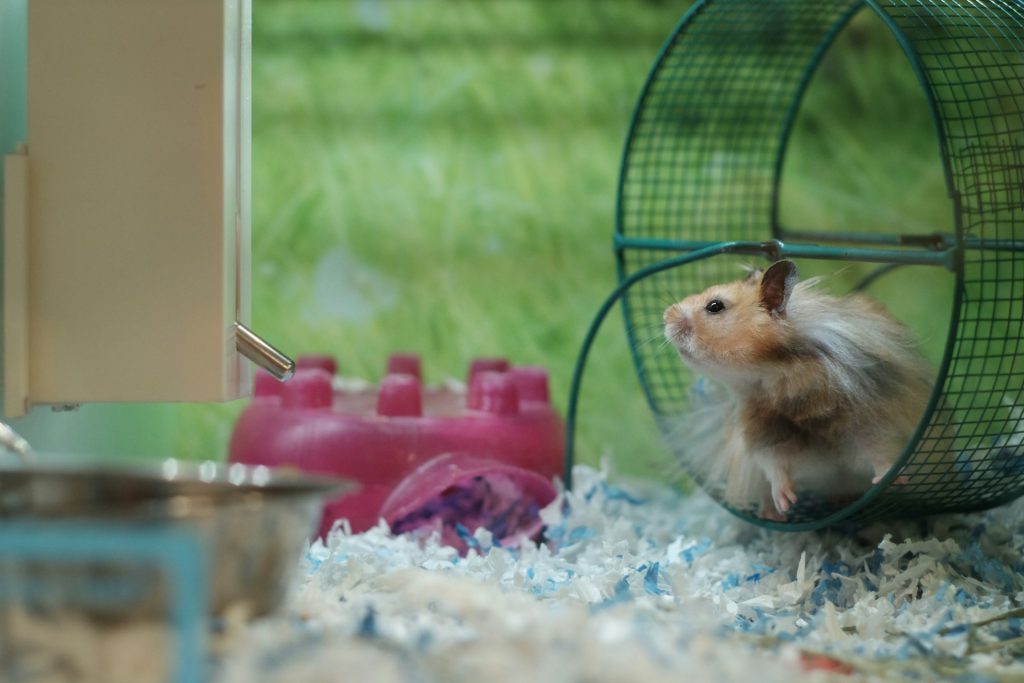3. Give Real Digging Depth: 6–8 Inches of Compressible Bedding
The most important upgrade in a hamster apartment setup is deep, diggable substrate. Aim for at least 15–20 cm (6–8 in) of soft, compressible bedding so your hamster can tunnel and nest naturally. Paper-based bedding mixed with kiln-dried aspen shavings strikes a good balance of traction, structure, and odor control; add pockets of shredded paper or hay to encourage burrow building. Deep substrate keeps hamsters busy (less bar-chewing and night pacing) and absorbs moisture far better than a thin layer.
Skip aromatic softwoods (like cedar) and dusty litters. Create a separate “sand spa” in a ceramic dish for coat care (use sterilized play sand, not clumping cat litter). For housing fundamentals—footprint, layout, and furnishings—cross-check practical guidance in Burgess Pet Care’s housing guide.
4. Escape-Proof the Layout: Bar Spacing, Latches, and Mesh Lids
Dwarfs can squeeze through shockingly small gaps. Keep bar spacing species-appropriate, add spring clips to doors, and use a rigid mesh lid on open-top bins or tanks. Route water-bottle nozzles through tight grommets and seal around cables with tidy rubber passthroughs. Place shelves or décor at least a wheel’s width from the side so an ambitious jumper can’t launch out during cleaning.
Need visual inspiration that fits apartments? Study proven, escape-proof builds in Hamster Welfare’s Amazing Setups to copy floor-space planning, hideout clustering, and lid solutions without trial-and-error.
5. Control Night Noise: Wheel Mounting, Vibration Damping, and Room Choice
Most noise complaints trace back to vibration, not volume. Mount your wheel to a rigid panel, then place the enclosure on a stable table with rubber feet or a thin cork mat to decouple vibrations from the floor and shared walls. Shift the habitat to an interior room if you can; a small white-noise machine outside the cage smooths the soundscape without stressing your hamster.
Keep aerosols, plug-in scents, and candles out of the habitat room, and verify any questionable products against the ASPCA Animal Poison Control list. For apartment-wide freshness that doesn’t rely on fragrance, borrow tactics from our odor control guide.
6. Map Zones: Nest, Dig, Run, Sand Bath, and Food/Water (No-Clutter Flow)
The most reliable way to keep a hamster apartment setup tidy is to design clear “zones.” Think of the enclosure like a small studio apartment: a deep “dig zone” (6–8 in of compressible bedding) for burrows, a quiet “nest zone” with two hideouts, a “run zone” for the wheel, a ceramic “sand bath” dish for coat care, and a compact “kitchen” with water and food. Keep zones visually separated with low tunnels or bridges so bedding stays where it belongs and your hamster can circulate without bottlenecks.
Place the wheel on the opposite end from the nest so midnight marathons don’t disturb sleep. Cluster heavier decor (ceramic hides, bridges) over deeper substrate to prevent cave-ins. For proven layouts you can copy, study real-world examples in Hamster Welfare’s Amazing Setups, and cross-check housing fundamentals (footprint, furnishing, enrichment) in Burgess Pet Care’s housing guide.
7. Set a Quick Routine: 3-Minute Daily Spot Clean, 20-Minute Weekly Reset
A simple routine beats occasional deep scrubs. Each day, scoop soiled areas around the “kitchen,” wipe the water-bottle nozzle, top up the sand bath, and fluff tunnels so air reaches the bedding surface. Keep a small hand vac and a lidded bin beside the cage so the whole process takes three minutes. Once a week, refresh a portion of the substrate (never 100%—leave “scent anchors” in the nest to reduce stress), rinse dishes, and check wheel bearings and door latches.
Skip perfumed sprays and plug-in scents; many aerosols and cleaners aren’t pet-safe—verify products against ASPCA Animal Poison Control. For keeping the rest of the apartment fresh without fragrances, borrow strategies from our odor control guide.
8. Add a Proper Sand Bath & Low-Cost Enrichment Rotation
A ceramic dish filled with sterilized play sand (not clumping litter) supports healthy coat care and gives your hamster a “spa” they’ll use daily. Place it near the wheel or a hideout for confidence. Rotate simple enrichment weekly—cardboard mazes, paper-bag forage stashes, and chew-safe bridges—to keep curiosity high without filling the cage with clutter. Keep chewables away from cables and fabrics outside the enclosure.
For inspiration that fits small spaces, browse enclosure ideas in Hamster Welfare’s Amazing Setups, and try a few budget toys from our DIY toys roundup. Thoughtful enrichment reduces bar-chewing and nighttime restlessness—key wins for apartment life.
9. Create a Secure Playpen for Safe Cleaning and Low-Stress Handling
A dedicated playpen makes apartment life easier: you can spot-clean or rearrange the enclosure without worrying about escapes. Choose low, smooth-sided panels on a waterproof mat; add one hideout so your hamster feels secure, plus a small bridge or tunnel to encourage exploration. Move your hamster to the pen before you lift décor or refresh substrate—cleaning goes faster, and your hamster stays calm because the playpen quickly becomes a predictable “second space.”
Keep the pen away from cables, curtains, and drafty doors, and never leave a hamster unattended outside the main habitat. If you use treats for easy transfers, place them in a shallow ceramic dish so crumbs don’t scatter. For layout inspiration that fits small apartments, study proven ideas and spacing solutions from Hamster Welfare’s Amazing Setups.
10. Keep Climate Stable: Gentle Airflow, No Drafts, No Direct Sun
Apartments can swing from stuffy to breezy quickly. Place the enclosure a few feet from windows, exterior doors, heaters/AC vents, and kitchens. Use sheer curtains to diffuse sunlight and a small fan on low that moves air past—not into—the cage. A simple thermometer/hygrometer helps you notice patterns (afternoon heat, nighttime chills) so you can adjust curtains or airflow before your hamster gets uncomfortable.
Avoid scented candles, aerosols, and plug-in fragrances around small animals; verify any questionable product against the ASPCA Animal Poison Control guidance. For furnishings and overall enclosure design that support comfort and ventilation, cross-check practical housing tips in Burgess Pet Care’s housing guide.
11. Pack a Tiny “Go-Bag” and Practice a 60-Second Transfer
Preparation is everything in a small space. Keep a soft carrier (or ventilated small-animal box), a folded towel or fleece square, a small bag of bedding, a sealed portion of food, and a water bottle in a single tote near the door. During cleaning day, practice a calm 60-second transfer: open the hideout into a small cup or tunnel, then slide your hamster gently into the carrier. Familiarity with the routine means less stress if you ever need to leave quickly.
For evacuation checklists and pet-focused tips, bookmark the Red Cross pet disaster preparedness guide, and see our apartment-ready checklist in Pet Emergency Preparedness in Apartments. A compact plan keeps you compliant with building rules and protects your deposit by preventing last-minute messes.
12. Chew-Proof Everything: Cords, Corners, and “Can’t-Reach” Routes
Apartment living means cables everywhere—prime targets for tiny teeth. In your hamster apartment setup, route cords up the back of furniture (not across floors) and enclose them in split-loom tubing or rigid cord channels. Use a cable box at power strips, and slide furniture tight to the wall to block access. If the habitat sits near baseboards, add a clear acrylic or coroplast guard at nibble height so paint and wood stay intact. Offer safe chews (willow, apple wood, cardboard “gnaw sticks”) to redirect the instinct to shred—and rotate them weekly so they stay interesting.
Keep plug-in scents, aerosol cleaners, and essential oils out of the habitat room; many common products can be hazardous to small animals—when in doubt, cross-check the ASPCA Animal Poison Control resources. Good cable management plus purposeful chew options protects your gear, your deposit, and your hamster.
13. Respect Species Needs: Solo Housing, Low-Stress Handling, Predictable Nights
Most hamsters—especially Syrians—are solitary and should be housed alone to prevent fights and stress. Design the enclosure for independent enrichment: deep dig zones, two hideouts, a proper sand bath, and a truly quiet wheel placed away from the nest. Handle during calm, wakeful periods (usually evening), and keep a consistent lights-down routine so nights feel predictable. During weekly refreshes, avoid removing 100% of the nest; leave a little used bedding as a familiar “scent anchor” to reduce agitation after cleaning.
For housing fundamentals—footprint, furnishing, and comfort cues—review practical guidance in Burgess Pet Care’s housing guide, and browse real-world, apartment-friendly layouts in Hamster Welfare’s Amazing Setups. A species-appropriate plan keeps behavior calm, noise down, and your setup renter-friendly.
14. Make It Lease-Friendly: Protect Floors, Walls, and Shared Walls
A polished hamster apartment setup should look intentional and landlord-safe. Place the enclosure on a waterproof layer (vinyl runner, coroplast sheet, or washable mattress protector) that extends a few inches beyond the base to catch stray bedding. Add felt or rubber pads under the table/stand to prevent vibrations transferring through floors and shared walls. If the habitat sits near baseboards, install a clear acrylic or coroplast splash/chew guard at nibble height so paint and trim stay pristine.
Keep cleaning simple and scent-safe: wipe hard surfaces with diluted white vinegar, rinse, and dry thoroughly; avoid perfumed sprays and aerosols around small animals—verify anything questionable against the ASPCA Animal Poison Control guidance. Lease-friendly protection plus your vibration-damping wheel setup (Tip 5) keeps neighbors happy and deposits intact.
15. Create a One-Shelf “Nutrition Station” + Drip-Proof Water Setup
Centralize food and water so feeding stays quick and mess-free. Use airtight containers for pellets and seeds, and prep small veg portions in a fridge bin lined with a paper towel. Mount the water bottle so the nozzle sits just above shoulder height; place a ceramic tile or cork square beneath the nozzle inside the cage to catch drips and protect substrate. Keep a spare bottle ready so swap-outs take seconds during weekly maintenance.
Review practical housing and furnishing pointers (including dish placement and furnishing balance) in Burgess Pet Care’s housing guide. A tidy “nutrition station” plus deep substrate and a silent wheel rounds out a balanced, low-odor routine that fits apartment life.
Final Thoughts
With smart layout, deep diggable bedding, a truly quiet wheel, and safe cleaning habits, a hamster apartment setup can be peaceful, low-odor, and easy to maintain—even in the smallest rentals. Map clear zones (nest, dig, run, sand bath, kitchen), use vibration damping to keep nights quiet, and chew-proof cords and corners to protect both your pet and your deposit. Keep routines light (3-minute daily, 20-minute weekly), and prepare a tiny go-bag so you’re ready for anything. The result is a calm, enriching habitat that blends into your home and keeps your little sprinter thriving.
Frequently Asked Questions
What should a hamster apartment setup include?
A safe enclosure with species-appropriate bar spacing, a large-diameter quiet wheel, 6–8 inches (15–20 cm) of diggable bedding, at least two hideouts, a ceramic sand bath, and a compact “kitchen” area for food and water. Keep the cage away from drafts, direct sun, and fumes; verify questionable products via ASPCA Animal Poison Control. For housing fundamentals and layout inspiration, see Burgess Pet Care’s housing guide and Hamster Welfare’s Amazing Setups.
How deep should hamster bedding be in a small apartment?
Aim for 6–8 inches (15–20 cm) of soft, compressible substrate so your hamster can tunnel and nest naturally. Mix paper-based bedding with kiln-dried aspen for structure, and offer a separate ceramic dish of sterilized play sand for coat care. Deep substrate reduces bar-chewing and helps with odor control in tight spaces—pair it with apartment-wide freshness tactics from our odor control guide.
How do I keep the wheel quiet at night?
Choose a large, closed-back wheel with smooth bearings and mount it to a rigid panel or stable stand. Place a thin cork or rubber pad under the enclosure to damp vibrations, and keep the habitat on a sturdy table away from shared walls. Check bearings weekly and replace worn parts before they rattle.
Where should I place the cage in an apartment?
In a bright room with gentle airflow—several feet from windows, heaters/AC vents, kitchens, and exterior doors. Use sheer curtains to diffuse sun and a small fan on low that moves air past (not into) the cage. Avoid scented candles and aerosol cleaners; verify safety via the ASPCA.
How often should I clean a hamster cage in a small apartment?
Do a quick 3-minute daily spot clean (soiled areas, water nozzle, sand refresh) and a 20-minute weekly reset. Don’t replace 100% of the bedding at once—leave some “scent anchors” in the nest to reduce stress. Store supplies in a vertical bin beside or under the stand to keep clutter out of your living space.






